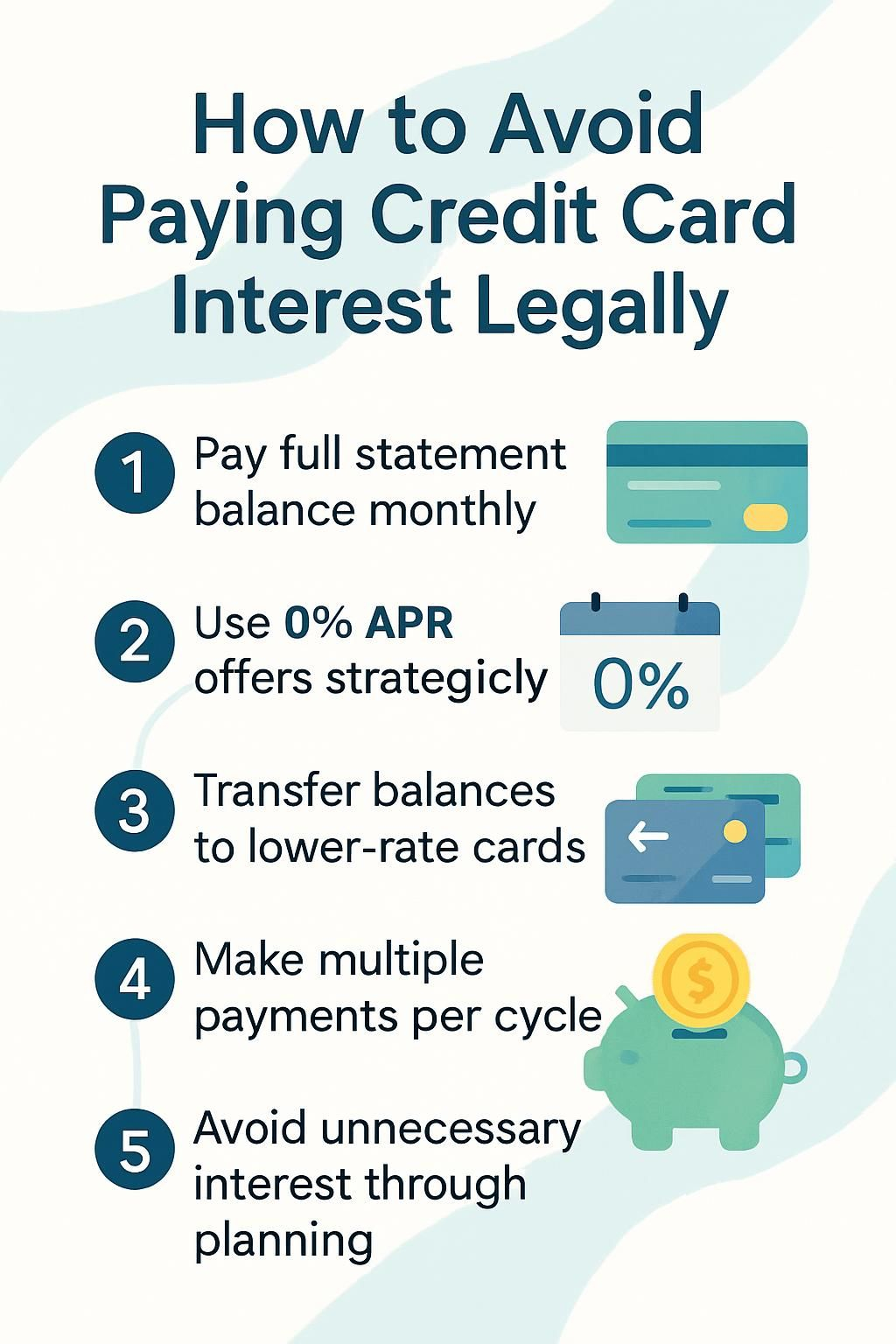How to Avoid Paying Credit Card Interest Legally
Many people feel frustrated by credit card interest charges piling up each month. If you pay your full statement balance by the due date, most credit cards will not charge you interest because of the grace period.
This guide explains how simple steps, like on-time payments and using 0% APR offers, can help you legally avoid paying extra to your credit card company. Discover smarter ways to keep more of your money.
Key Takeaways
- Paying the entire statement balance before the due date each month can prevent interest charges, maintaining the grace period advantage of credit cards. Setting up automatic payments can assist with timely payments, thereby protecting one’s credit rating.
- Using 0% APR offers allows you to pay off balances without incurring interest for a specific time frame. Choosing a card that aligns with your financial needs involves closely reviewing terms and potential charges.
- Transferring balances to a card with a lower interest rate can help consolidate debt and decrease overall interest costs if managed effectively. This process requires understanding related charges, promotional duration, and ensuring punctual payments to avoid standard rates after the promotion.
- Making several payments within the billing cycle can lower the average daily balance used to calculate compound interest, resulting in cost savings on accrued interests over time.
- Tactics like wisely using 0% APR offers, cautiously using balance transfer options while being aware of their related costs, and making frequent payments can serve as proactive ways to manage credit efficiently without attracting unnecessary expenses from interest charges.

How to Pay Your Balance in Full Each Month

Pay your card statement balance in full each billing cycle to avoid credit card interest charges. Set up automatic payments through your online banking or checking account so you never miss a due date and protect your credit score.
What is a credit card grace period and how can I use it?
A credit card grace period covers the span from your statement’s closing date to the payment due date, often around 21 to 25 days. During this window, banks and credit card issuers do not charge interest on new purchases if you settle the full statement balance by the deadline.
Paying only part of your balance or missing the due date means interest accrues on new transactions right away, wiping out this benefit.
By always paying off each month’s full amount from your billing statement before the due date, you preserve your grace period and avoid all interest charges on purchases. You can set up automatic payments through most banking apps or websites for added ease.
“Paying in full keeps every dollar working for you instead of against you,” says personal finance advisor Dave Ramsey. This simple move helps guard your cash flow and protects your strong credit score without needing extra loans, debt consolidation plans, or support from a credit counselor.
Why should I avoid carrying over balances?
Once you understand how a credit card grace period works, it’s easy to see why carrying over balances is risky. Losing your grace period results in interest charges on every new purchase right away.
Even luxury cards from Bank of America or Discover.com will charge you daily compounded interest if you leave any portion unpaid. Interest rates often exceed 20 percent annual percentage rate; that can mean thousands in extra costs each year for high spenders.
Interest on cash advances begins the moment the transaction occurs and includes a substantial cash advance fee, which accumulates quickly if not paid off immediately. Credit card companies also report carried-over debt to all three major credit bureaus, affecting your FICO score and credit history as a whole.
Having revolving credit at a high balance lowers your score, which influences future car loans or home mortgages through mortgage lenders. Paying only the minimum payment allows compound interest to grow your debt quickly while reducing your financial flexibility and limiting opportunities for rewards like cash-back or frequent-flyer miles from premium cards.
What Are the Benefits of a 0% APR Credit Card?
A 0% annual percentage rate (APR) credit card lets you make purchases or transfer balances without paying any interest for a set time. This offer can help you direct more of your money toward reducing your principal balance, instead of throwing it away on interest payments to the credit card issuer.
How do I find cards with introductory 0% APR offers?
Locating cards with initial 0% APR offers needs a careful approach. This technique gives individuals the benefit of interest-free periods, especially useful for big purchases or consolidating debt. Here’s the strategy:
- Initiate by examining different credit card issuers. Numerous banks and financial companies often advertise cards with 0% introductory APR offers.
- Evaluate various credit card websites and online comparison aids. These resources have lists of credit cards with promotional APR periods, making it simple to filter options based on the duration of the 0% APR time.
- Be vigilant about balance transfer cards during your exploration; these typically have a 0% APR offer for a certain period, perfect for merging debt from other high-interest cards.
- Seasonal promotions and specific marketing drives are common among credit card corporations aiming to attract new consumers with 0% APR offers, so stay tuned to advertisements especially around holiday times or financial quarters.
- Use online tools that compare features of different credit cards side by side, focusing on ones that emphasize initial rates and other perks such as cashback rewards or loyalty points.
- Examine customer reviews and ratings available on finance forums and review sites. These user accounts can reveal the card’s real value beyond its initial offer, assessing factors like customer service and usability.
- Examine every possible card’s terms regarding the promotional offer closely; this includes understanding the duration of the 0% APR, to which transactions it applies (purchases vs balance transfers), and the rate it will change to after the promotion concludes.
- Stay aware of fees related to the card or specific transactions like balance transfers as these can affect the total savings you might achieve during the promotional period.
Each stage demands careful thought but can guide you to locate a credit card that offers a useful 0% introductory APR and also meets other financial needs such as enhancing your credit score through responsible use or earning rewards on purchases.
When should I pay off the balance before the offer ends?
Pay off your credit card balance in full before the 0% APR introductory period expires, or you will face high interest charges. For example, if your promotional offer ends on December 31st, schedule payment for several days before that date to avoid any processing delays with your credit card issuer.
Setting up automatic payments from your checking account can help ensure every statement balance clears on time and keeps you protected against late fees. The Consumer Financial Protection Bureau recommends making multiple smaller payments throughout the month to keep both your average daily balance and risk of missed deadlines low.
A single day late could trigger standard annual percentage rates as high as 25 percent.
Check the fine print in your credit card agreement to track when the promotional rate resets. Mark this date on a calendar or set digital alerts so you do not miss it. If possible, pay a lump sum well ahead of the expiration and confirm receipt through online banking tools before relying solely on email confirmations or paper statements.
This approach will safeguard both your credit score and financial health by completely avoiding unexpected interest charges after an introductory offer runs out.
How Can I Consolidate Debt with a Balance Transfer?
You can move your outstanding credit card balances to a new account with a lower interest rate. This strategy gives you a chance to save money on interest charges and simplify your monthly payments.
How do I transfer balances to a low or 0% APR card?
Transferring balances to a card with a low or 0% APR can save you a lot on interest. This move requires a solid understanding of the terms and conditions associated with balance transfers. Here is how you can do it effectively:
- Research offers from various credit card issuers to find those providing low or 0% introductory APR deals. Major banks and credit unions often have these promotions.
- Check your current credit score and report. A good to excellent credit score increases your chances of qualifying for the best balance transfer deals.
- Apply for a credit card that offers a 0% APR on balance transfers. This step involves filling out an application form, either online or in paper form, and waiting for approval from the issuer.
- Read the fine print of your new credit card agreement carefully. It contains crucial information about the duration of the promotional period, the one-time transfer fee, and other charges.
- Contact your new credit card company to initiate the balance transfer process. You may need to provide details of your old accounts and specify how much money you want to transfer.
- Keep an eye on both old and new account statements after initiating the transfer. This vigilance ensures that the transaction goes through smoothly without any missed payments.
- Continue making payments on your old account until you confirm that the balance has moved successfully to avoid late fees and potential damage to your credit score.
- Plan how you will pay off this transferred balance before the introductory rate expires to sidestep high-interest charges on remaining debt.
- Set up automatic payments for at least the minimum amount due each month if paying off the entire transferred balance before the end of the promotional period might not be possible.
Following these steps allows for an efficient strategy in managing existing debt, potentially saving significant amounts in interest charges over time while aiding in maintaining or improving one’s credit health through diligent management practices.
What fees and time limits should I watch for on promotions?
Using balance transfer cards wisely can save you a lot on interest charges. You must pay close attention to fees and promotional time limits to make the most of these offers. Here are essential points to consider:
- Most credit card issuers charge a one-time balance transfer fee, which usually ranges from 3% to 5% of the amount transferred. This fee adds to your total balance, affecting the cost savings of transferring your debt.
- The introductory 0% APR period doesn’t last forever; it typically spans 12 to 18 months after you open the account. Mark this expiration date in your calendar because any remaining balance after this period will accrue interest at the standard APR.
- Credit card agreements detail how missing a payment might terminate your promotional APR offer prematurely. Always set up automatic payments for at least the minimum amount due to avoid this pitfall.
- Understand that promotional offers have eligibility requirements based on your credit score or history with the issuer; not everyone qualifies for every deal.
- The time limit for completing a balance transfer after opening an account often gets overlooked. Some cards require transfers within a certain number of days (usually 30 to 60) from account opening to qualify for the low or no interest promotion.
Next, let’s explore why making multiple payments per month could be a game-changer in managing your credit card debt effectively.
Why Make Multiple Payments Per Month?
Making multiple credit card payments each month can help lower your average daily balance and reduce interest charges. This habit shows credit card issuers that you manage your line of credit wisely and may lead to a higher credit score.
How can multiple payments reduce my average daily balance?
Splitting your credit card payment into smaller amounts throughout the month drops your average daily balance. For example, instead of sending one large credit card payment after you receive your statement, you can pay off part of your balance every week or right after making a significant purchase.
This strategy means that for more days in the billing cycle, a lower outstanding amount gets reported to the credit card issuer.
A reduced average daily balance means less compound interest accrues on unpaid balances under most credit card agreements. Issuers calculate interest charges using this figure rather than just looking at what you owe at the end of each period.
The Federal Trade Commission explains that even if you make new purchases early in the cycle, paying them off quickly helps avoid extra charges and keeps cash advance fees and late fees low.
To get even larger benefits from multiple payments per month, consider pairing this habit with 0% APR introductory rate offers before transferring balances for consolidation purposes.
How do multiple payments minimize interest accrual?
Multiple payments each month slash your average daily balance, which directly controls how much interest credit card issuers can charge. Lower balances mean less compound interest added to what you already owe.
For example, if you use a Visa card with a $20,000 limit and make three payments of $2,500 after large purchases throughout June 2023 instead of waiting for the statement date, fewer days pass where you’re carrying high amounts.
The result is lower interest charges when the issuer calculates based on those daily owed totals.
I have found this helpful in keeping my own monthly bills low even during high-spending periods such as holidays or travel seasons. Making several payments helps avoid late fees and protects your credit score by showing the issuer responsible payment habits that appear on your credit report.
Consistently taking this approach also protects against missing out on your grace period or incurring extra cash advance fees because you unexpectedly hit a higher debt threshold before payday.
Conclusion
Paying your credit card statement balance in full every month is the most reliable way to avoid interest charges. Use the grace period wisely and never let balances roll over to the next cycle.
0% APR offerings, balance transfers, and personal loans provide extra tools for managing or consolidating debt at a lower cost. Make payments throughout the month to keep balances down and limit any interest that might accrue on new purchases.
With smart choices and attention to due dates, you can maintain strong credit scores while keeping more of your money working for you instead of against you.
FAQs
1. What is credit card interest and how does it work?
Credit card interest, also known as the annual percentage rate (APR), is a fee charged by your credit card issuer for borrowing money. Compound interest applies when you carry a balance beyond the grace period, meaning you’re paying interest on both the original amount spent and any accumulated interest charges.
2. How can I avoid paying credit card interest legally?
You can avoid paying credit card interest legally by always paying off your statement balance in full before the end of your grace period. Avoid cash advances as they often incur an immediate cash advance fee and high-interest rates with no grace period.
3. Can transferring my debt to another credit card help me avoid interests?
Yes, through a strategy called balance transfer where you move your current debt to a new or existing credit line offering lower introductory rates or even zero percent APR for a certain duration. However, ensure to understand all terms in the credit card agreement including potential late fees and impact on your debt-to-income ratio (DTI).
4. How can improving my credit score help reduce my overall costs?
A strong credit history leading to higher scores may qualify you for cards with better terms such as lower APRs or more generous rewards like cash back options which effectively reduces what you owe.
5. What if I’m unable to manage my debts alone? Are there professional services available?
Yes! Credit counselors offer professional advice on effective debt management strategies such as budgeting, consumer education about fair lending practices under Fair Credit Reporting Act guidelines, and even coordinating with creditors for possible debt settlement plans.
6. Besides using other forms of loans like personal loans or home equity lines of credits (HELOCs) are there alternative strategies that could be considered?
Definitely! Strategies like timely payment habits avoiding late fees; keeping balances low relative to available limits; not opening unnecessary new accounts that might negatively affect average account age; seeking assistance from consumer financial protection bureau (CFPB) or network advertising initiative for unfair practices; and even considering life insurance policies as collateral for loans could be considered.

 Previous Post
Previous Post Next Post
Next Post